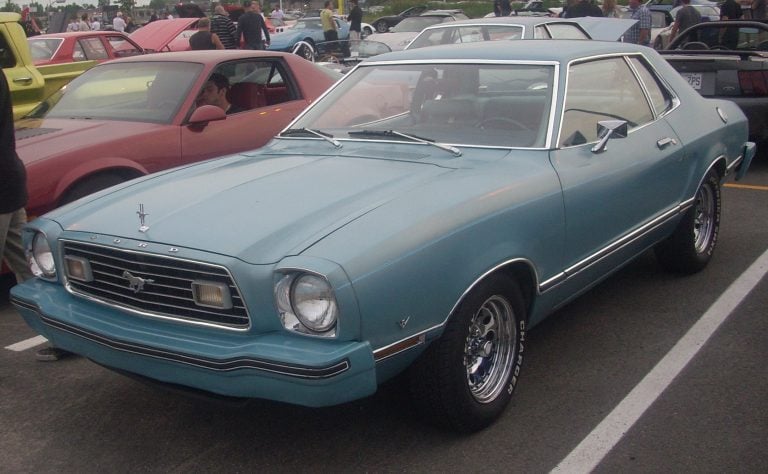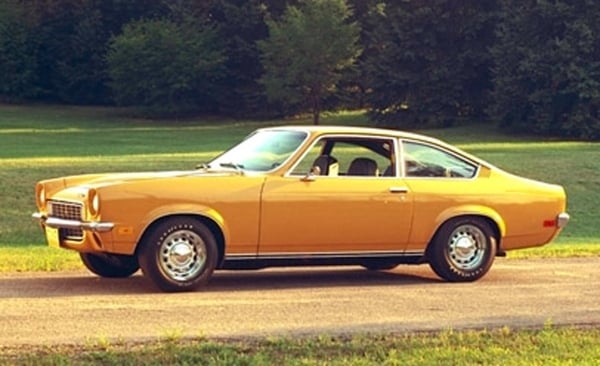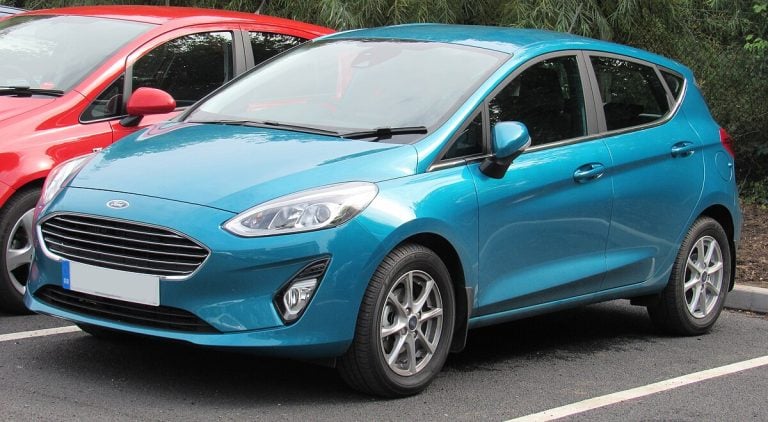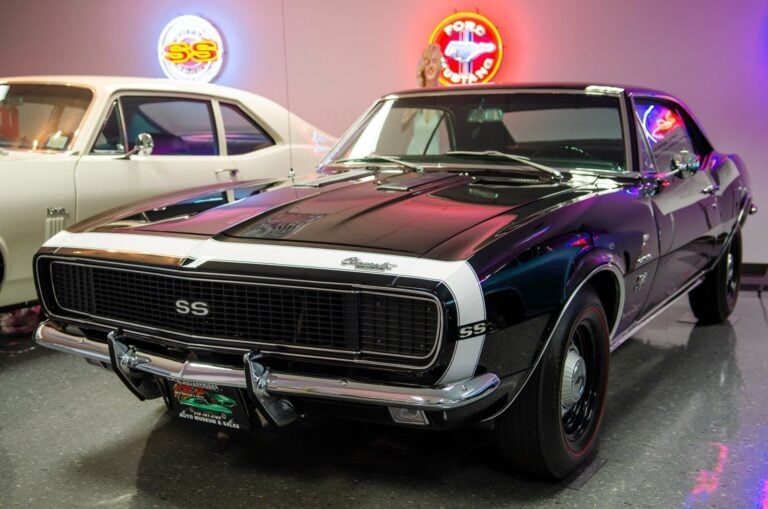The 30 Best American Car Models Ever Made
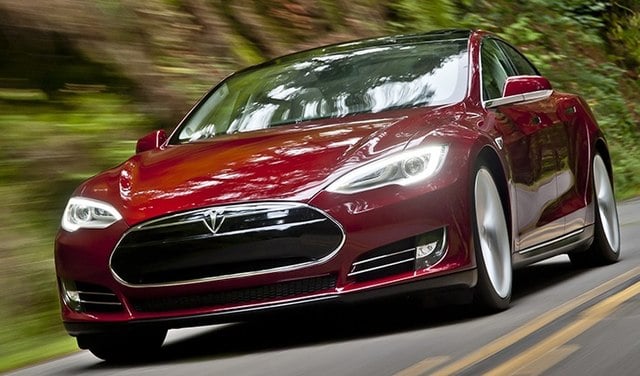
American automotive history spans over a century of groundbreaking innovation, from the introduction of mass production techniques to the development of cutting-edge electric vehicles.
The nation’s car manufacturers have consistently pushed boundaries in performance, design, and technology, creating vehicles that have become cultural icons worldwide.
This comprehensive ranking examines the most influential and exceptional American car models that have shaped the automotive landscape through their engineering excellence, cultural impact, and lasting legacy.
The selection encompasses everything from revolutionary electric vehicles and high-performance supercars to legendary muscle cars and dependable trucks that defined entire generations.
These models represent the pinnacle of American automotive achievement, demonstrating how domestic manufacturers have continuously evolved to meet changing consumer demands while maintaining their distinctive character and innovation.
Here are the 30 best American car models ever made:
1. Tesla Model S Plaid
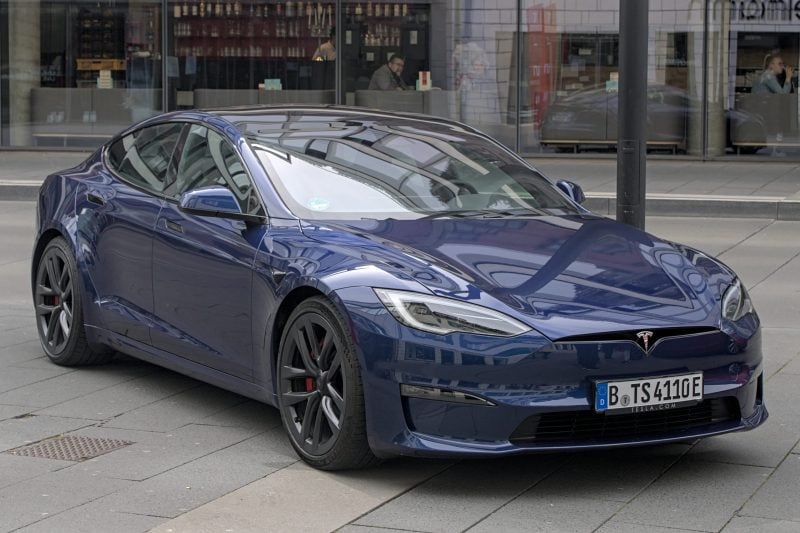
The Tesla Model S Plaid represents the pinnacle of American electric vehicle engineering. Tesla unveiled this variant in 2021 as part of their mission to build the world’s best car.
The Plaid delivers extraordinary performance with a 0-60 mph time of 2.1 seconds. This acceleration capability has been recognized by MotorTrend as the fastest they have ever tested in their 70-plus years of automotive journalism.
Three electric motors generate over 1,000 horsepower in the Plaid configuration. The motors feature rotors wrapped in carbon sleeves, delivering smooth power delivery across the entire performance range.
The Model S Plaid holds the record for the fastest quarter-mile time ever achieved by a production car. Despite its track-focused performance, it remains practical for daily driving with a quiet, comfortable interior and full-size sedan utility.
2. Ford Mustang
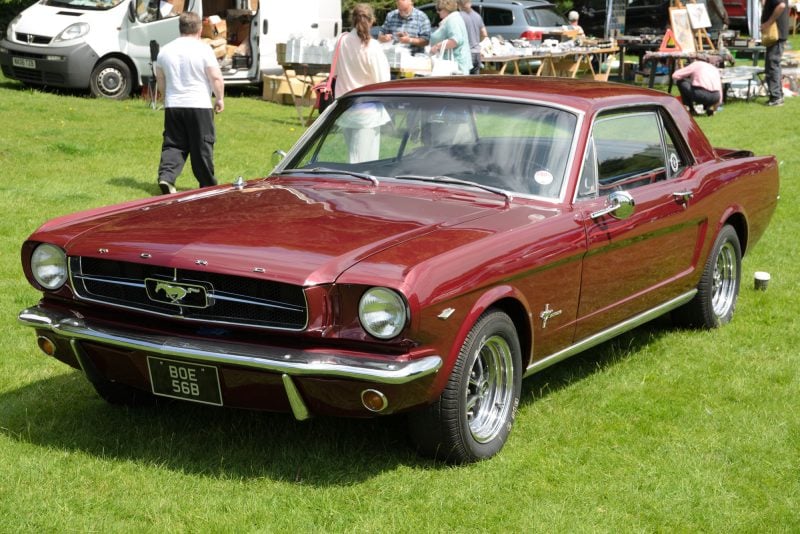
The Ford Mustang debuted in 1964 as America’s original pony car. It created an entirely new automotive segment that combined sporty styling with affordable pricing.
Ford’s marketing confidence showed when they sent journalists on 750-mile test drives from New York. The bold move paid off as the Mustang became an instant cultural phenomenon.
The 1965 GT package transformed the standard Mustang into a true performance machine. This marked the beginning of the muscle car era in American automotive history.
Shelby American’s GT350 took performance further with race-inspired modifications. The fastback featured upgraded suspension, specialized tires, and enhanced handling capabilities.
Modern Mustangs maintain the original’s spirit while delivering contemporary performance. The 2020 Shelby GT500 produces 760 horsepower from its supercharged V-8 engine.
Ford has produced over 10 million Mustangs across six decades. The model remains America’s longest-running sports car nameplate.
3. Chevrolet Corvette

The Chevrolet Corvette debuted in 1953 as America’s answer to European sports cars. Only 300 units of the original C1 were produced that first year.
The early Corvette featured a fiberglass body and sleek design that was revolutionary for its time. It initially came with a modest 150-horsepower inline-six engine.
In 1955, Chevrolet introduced the legendary small-block V8 engine to the Corvette lineup. This addition transformed the car’s performance capabilities significantly.
The 1963 Stingray became an instant icon with its distinctive split rear window design. The flowing body lines captured the imagination of sports car enthusiasts nationwide.
Over seven decades, Chevrolet has produced approximately 1.3 million Corvettes across eight generations. The nameplate remains one of the longest-running and most successful American sports cars ever created.
4. Dodge Charger
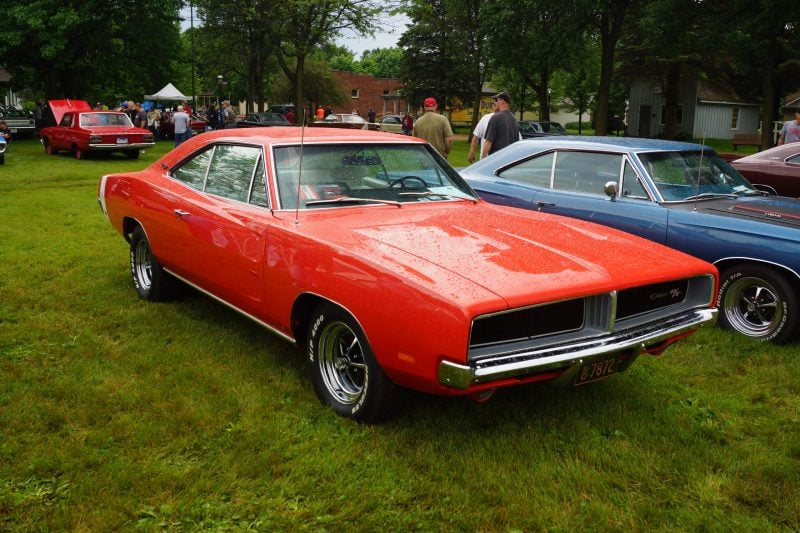
The Dodge Charger debuted in 1966 and immediately established itself as an American muscle car icon. Its aggressive styling and powerful V8 engines captured the essence of American automotive performance.
The 1970 Charger R/T remains widely regarded as the greatest model in the nameplate’s history. This generation featured the classic fastback design that defined muscle car aesthetics for decades.
Throughout its production run, the Charger underwent significant transformations. It evolved from a two-door muscle car to a four-door sedan while maintaining its performance-focused identity.
The Charger’s cultural impact extends beyond automotive circles. Its numerous appearances in films and television shows cemented its status as a symbol of American car culture.
Modern Charger models continue the legacy with powerful engines and bold styling. The nameplate has survived nearly 60 years, proving its enduring appeal to American car enthusiasts.
5. Jeep Wrangler
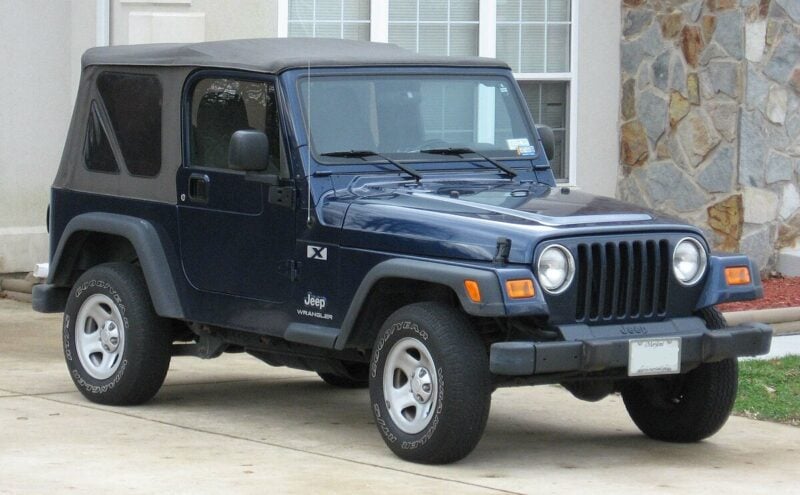
The Jeep Wrangler stands as one of America’s most recognizable vehicles. Its distinctive design and rugged capabilities have made it an icon since its introduction.
The Wrangler traces its lineage to the military Willys MB from World War II. This heritage established the foundation for decades of off-road excellence.
The YJ generation (1987-1995) brought square headlights and improved everyday drivability. Despite initial criticism, it became a unique piece of automotive history.
Modern Wranglers maintain their core identity while adding contemporary features. The 2018 Rubicon model exemplifies this balance of tradition and innovation.
Wrangler owners share a special bond, often exchanging waves when passing on roads. This community spirit reflects the vehicle’s cultural significance beyond transportation.
The model’s removable doors and fold-down windshield offer unmatched open-air driving experiences. These features remain rare in today’s automotive landscape.
6. Cadillac Eldorado
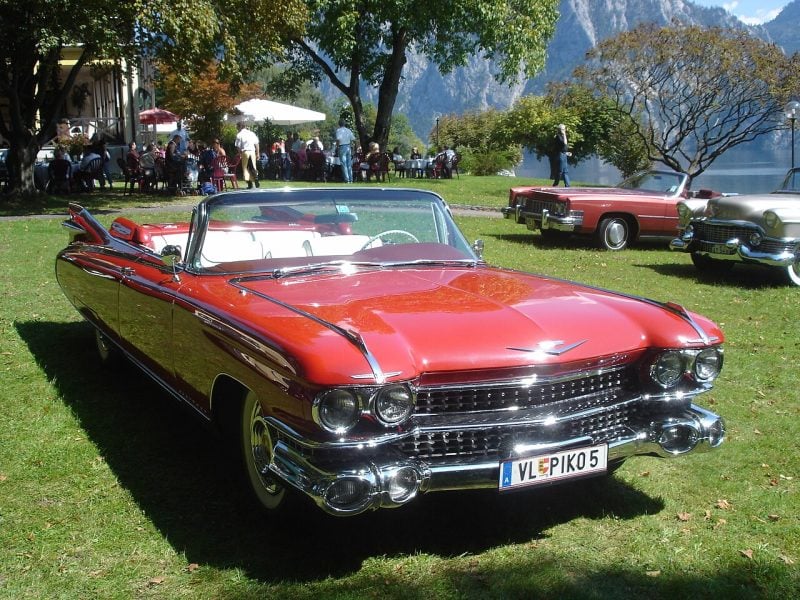
The Cadillac Eldorado stands as one of America’s most recognizable luxury vehicles. Production ran from 1953 to 2002, spanning nearly five decades of automotive evolution.
The 1959 Eldorado Biarritz represents the model’s pinnacle. This convertible featured extensive chrome detailing and a powerful 345-horsepower engine. Its wraparound windshield and distinctive styling defined American automotive excess.
Earlier models from 1957-1958 established the Eldorado’s reputation for luxury. The original design included front bumper bullets and premium appointments that were considered extras on other Cadillac models.
The Eldorado became synonymous with American success and style. Its imposing presence and luxurious features made it a favorite among celebrities and business leaders throughout its production run.
This model helped cement Cadillac’s position as America’s premier luxury automaker for generations.
7. Ford F-150

The Ford F-150 stands as America’s best-selling vehicle for decades. This full-size pickup truck has dominated the market since its introduction in 1975.
Ford builds the F-150 in American factories located in Kansas City and Dearborn. The truck offers impressive capability with towing capacity up to 10,800 pounds.
The F-150 provides seating for five passengers and available four-wheel drive. Multiple engine options include efficient V6 models and powerful V8 variants.
The truck surpassed even Ford’s legendary Model T as the company’s best-selling vehicle of all time. Commercial buyers and families alike choose the F-150 for its versatility.
Ford offers specialized versions like the high-performance Raptor with 450 horsepower. The F-150 combines work capability with daily driving comfort across all trim levels.
8. Chevrolet Camaro

The Chevrolet Camaro debuted in 1967 as General Motors’ direct response to the Ford Mustang. This pony car became an instant icon in American automotive history.
The 1969 Camaro represents the model’s peak classic era. Special variants like the Yenko Camaro, created by Pennsylvania dealer Don Yenko, delivered exceptional performance that defined the muscle car generation.
Chevrolet discontinued the Camaro in 2002 but revived it in 2010. The fifth-generation model drew design inspiration from the beloved 1969 version while incorporating modern technology and safety features.
The Z/28 badge has consistently marked the Camaro’s high-performance variants throughout its production run. These models featured upgraded engines, suspension components, and racing-derived technology.
Production of the Camaro ended in 2024, closing a 57-year chapter in American automotive history. The final ZL1 Collector’s Edition served as a fitting tribute to this legendary nameplate.
9. Pontiac GTO

The Pontiac GTO earned its place as the original American muscle car when it debuted in 1964. Initially offered as an option package for the LeMans, the GTO combined a powerful V8 engine with intermediate-sized styling.
Pontiac marketed the car as “The Great One” and exceeded all sales expectations in its first year. The success prompted General Motors to make the GTO a standalone model for 1965.
The classic GTO ran through 1974, with the peak performance years occurring between 1964 and 1970. These models featured engines ranging from 389 cubic inches to the legendary 455 big block.
After a three-decade hiatus, Pontiac revived the nameplate in 2004 using the Australian Holden Monaro platform. This modern interpretation offered contemporary performance but lasted only until 2006 when Pontiac discontinued the brand.
The GTO’s influence on American automotive culture remains significant, establishing the muscle car template that competitors would follow for decades.
10. Buick GNX
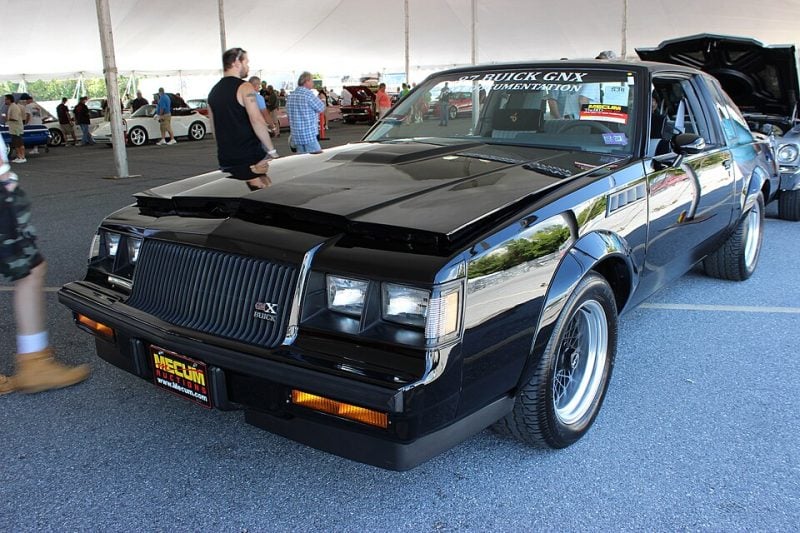
The 1987 Buick GNX stands as one of America’s most legendary muscle cars. Only 547 units were produced during its single model year, making it exceptionally rare.
Built on the Regal platform, the GNX represented the pinnacle of Buick’s Grand National lineup. The car featured a turbocharged 3.8-liter V6 engine that delivered impressive performance numbers for its era.
Its sinister black exterior and aggressive styling created an intimidating presence on the road. The GNX successfully challenged the traditional V8 muscle car formula with forced induction technology.
Performance enthusiasts recognized the GNX as a significant departure from Buick’s typical luxury focus. The car demonstrated that American manufacturers could build sophisticated high-performance vehicles during the 1980s.
Today, the GNX remains highly sought after by collectors and muscle car enthusiasts. Its limited production numbers and historical significance have cemented its status as an automotive icon.
11. Chrysler 300C
The Chrysler 300C emerged as a defining American luxury sedan that captured the essence of classic muscle car design. The original 300C debuted in 1957 as part of Chrysler’s prestigious Letter Series.
This model represented the third generation of Chrysler’s high-performance lineup from 1957 to 1960. The 300C established itself as one of the finest letter cars Chrysler ever produced.
Chrysler revived the 300C nameplate in 2004 following the Daimler-Chrysler partnership. The modern 300C brought back the bold, imposing presence that made the original famous.
The redesigned sedan featured a distinctive grille and muscular proportions that recalled Chrysler’s 1955 C-300 heritage. It successfully made full-size sedans appealing to a new generation of buyers.
The 300C proved that American automakers could create vehicles combining luxury appointments with aggressive styling cues that honored their performance legacy.
12. Lincoln Continental
The Lincoln Continental stands as one of America’s most recognizable luxury automobiles. Ford’s Lincoln division produced this iconic model from 1939 to 2020, establishing it as a symbol of American prestige.
The 1961 Continental represents the nameplate’s pinnacle achievement. After years of questionable design choices, Lincoln created a masterpiece of elegance and sophistication. This fourth-generation model featured distinctive suicide doors and clean, uncluttered lines.
The original Continental emerged from Edsel Ford’s personal vehicle project in 1939. His coachbuilt Lincoln-Zephyr convertible caught public attention and launched the Continental legacy.
The 1958 Mark III demonstrated American automotive excess at its peak. This massive unibody car claimed the title of largest ever produced in the United States, showcasing the era’s bigger-is-better philosophy.
Throughout its eight-decade run, the Continental maintained its position as Lincoln’s flagship model, representing traditional American luxury craftsmanship.
13. Chevrolet Bel Air
The Chevrolet Bel Air debuted in 1950 as a premium hardtop coupe within Chevrolet’s Deluxe model range. It quickly became the flagship of the Chevrolet passenger car lineup.
By 1953, the Bel Air had evolved into its own standalone model. The car represented the pinnacle of American automotive style during the post-war era.
The second-generation models from 1955-1957, known as “Tri-Fives,” became the most recognizable and sought-after versions. These cars featured distinctive two-tone paint schemes, chrome detailing, and powerful V8 engine options.
The Bel Air remained in production for over three decades, from 1950 to 1981. It offered both convertible and hardtop configurations throughout most of its production run.
This model became a symbol of American prosperity and automotive innovation. The Bel Air’s influence on car design extended well beyond its production years.
14. Ford Bronco
The Ford Bronco debuted in 1966 as Ford’s answer to the Jeep CJ and International Harvester Scout. Its rugged design and removable roof made it an instant hit among off-road enthusiasts.
The first-generation Bronco ran from 1966 to 1977 and remains the most revered model. Its simple construction and reliable performance established the nameplate’s reputation for durability.
Ford continued producing the Bronco through 1996, with each generation maintaining strong off-road capabilities. The vehicle became synonymous with American adventure and outdoor recreation.
After a 25-year hiatus, Ford revived the Bronco in 2021. The modern version honors the original’s design philosophy while incorporating contemporary technology and safety features.
Today, vintage Broncos rank among the most collectible SUVs in America. Their enduring popularity demonstrates the model’s significant impact on American automotive culture.
15. Tesla Model 3
The Tesla Model 3 revolutionized the electric vehicle market when it launched in 2017. It brought premium EV technology to a more accessible price point than previous Tesla models.
The Model 3 earned recognition as the most American-made vehicle for 2025 according to Cars.com’s annual index. The sedan contains 75% U.S. and Canadian parts content following its recent redesign.
Tesla assembles the Model 3 at its Fremont, California facility and Austin, Texas Gigafactory. This domestic production supports American manufacturing jobs and reduces dependence on foreign assembly.
The vehicle offers impressive performance with acceleration from 0-60 mph in as little as 3.1 seconds in Performance trim. Its minimalist interior centers around a 15-inch touchscreen that controls most vehicle functions.
The Model 3’s success helped establish Tesla as a major American automaker and accelerated the broader industry’s transition to electric powertrains.
16. Dodge Challenger
The Dodge Challenger stands as one of America’s most iconic muscle cars. First introduced in 1970, it embodied the raw power and aggressive styling that defined the muscle car era.
The original Challenger featured potent engine options, including the legendary 426 Hemi V8. Its bold design and performance capabilities made it an instant classic among automotive enthusiasts.
After a long hiatus, Dodge revived the Challenger nameplate in 2008. The modern version retained the vintage appearance while incorporating contemporary technology and safety features.
The 2018 Challenger SRT Demon represents the pinnacle of the model’s evolution. This street-legal drag racing machine demonstrated Dodge’s commitment to extreme performance.
The Challenger has become a modern muscle car benchmark. Its success as a retro-inspired vehicle proves that classic American automotive design principles remain relevant today.
17. Cadillac CTS-V
The Cadillac CTS-V represents American high-performance luxury at its finest. This sedan challenged European competitors with genuine racing credentials and supercar-level power.
The third-generation CTS-V from 2016-2019 stands as the pinnacle of the model’s evolution. It featured a 6.2-liter supercharged LT4 V8 engine borrowed from the Corvette Z06, producing tremendous horsepower.
This powerplant delivered track-ready performance in a practical four-door package. The CTS-V combined luxury appointments with serious handling capabilities and magnetic ride control suspension.
Car enthusiasts consider the later CTS-V models among the best American sedans ever produced. The vehicle successfully competed against established German performance sedans while maintaining distinctly American character.
The CTS-V proved American manufacturers could build world-class sports sedans. It earned recognition for its exceptional balance of comfort, luxury, and raw performance capability.
18. GMC Sierra
The GMC Sierra debuted in 1962 and has become one of America’s most enduring pickup trucks. With over 12 million units sold, it represents a cornerstone of General Motors’ truck lineup.
Since its modern iteration launched in 1988, the Sierra has earned recognition as one of the most reliable pickups on the market. The truck shares platforms with Chevrolet’s Silverado but maintains its distinct GMC identity.
The Sierra offers impressive towing capabilities and rugged construction that appeals to both commercial and personal users. Its versatile design accommodates various configurations, from work trucks to luxury models.
Multiple generations have refined the Sierra’s performance and features. The fourth generation, introduced for the 2014 model year, brought significant redesigns and improvements.
The Sierra’s success stems from its combination of durability, capability, and practicality that American truck buyers demand.
19. Ram 1500
The Ram 1500 has established itself as one of America’s most capable full-size pickup trucks since its introduction. Originally launched as the Dodge Ram in 1981, it became a standalone Ram brand in 2009.
The truck offers versatile engine options including a 3.6-liter V6, 5.7-liter V8, 3.0-liter EcoDiesel V6, and the supercharged 6.2-liter HEMI V8. Many configurations feature hybrid technology for improved efficiency.
Recent model years from 2017 to 2023 represent the best iterations of the Ram 1500. These trucks combine rugged capability with refined interiors and smooth ride quality.
The Ram 1500 demonstrates impressive durability with a potential lifespan exceeding 200,000 miles. This longevity rivals traditionally reliable vehicles like the Toyota Corolla and Honda Civic.
Its blend of performance, comfort, and practicality has made the Ram 1500 one of America’s best-selling trucks.
20. Ford Crown Victoria
The Ford Crown Victoria earned its place as an American automotive icon through decades of reliable service. Ford introduced the Crown Victoria name in 1955 as the top-of-the-line Fairlane model.
The full-size sedan became synonymous with durability and dependability. Its body-on-frame construction and rear-wheel drive configuration made it a favorite among law enforcement agencies nationwide.
Ford positioned the Crown Victoria as its largest sedan in North America, slotting it above the Taurus. The Mercury Grand Marquis served as its luxury counterpart throughout its production run.
The Crown Victoria achieved remarkable cultural significance beyond its practical applications. It holds the record for most movie appearances of any vehicle, with 6,874 appearances across over 70,000 pieces of film and television.
Production ended in 2011, marking the conclusion of Ford’s last traditional full-size sedan. The Crown Victoria represented the final chapter of American “land yacht” sedans.
21. Chevrolet Chevelle
The Chevrolet Chevelle debuted in 1964 as Chevrolet’s mid-sized offering. It filled the gap between the compact Nova and full-size Impala in the company’s lineup.
Production ran from 1964 to 1977, spanning 13 years of American automotive history. The Chevelle became one of America’s most recognized muscle cars during this period.
The Super Sport (SS) variants represented the performance pinnacle of the Chevelle line. These models featured powerful big-block V8 engines and aggressive styling that defined the muscle car era.
The 1970 Chevelle SS 454 stands as the most iconic version. It featured Chevrolet’s massive 454 cubic inch V8 engine producing substantial horsepower.
The 1966 Chevelle SS 396 also achieved legendary status with 72,272 units sold. This model solidified the Chevelle’s reputation as a true muscle car icon in automotive culture.
22. Oldsmobile 442
The Oldsmobile 442 launched in 1964 as a performance package for the F-85 model. It quickly became one of GM’s most respected muscle cars during the golden era of American performance vehicles.
The name “442” originally referenced its 4-barrel carburetor, 4-speed manual transmission, and dual exhaust system. This combination delivered the sporty performance that enthusiasts craved from their automobiles.
In 1970, GM lifted its corporate ban on engines larger than 400 cubic inches in intermediate bodies. This change allowed Oldsmobile to install the massive 455-cubic-inch “Rocket” V8 engine in the 442.
The W-30 package represented the ultimate 442 configuration. It featured enhanced engine components and performance modifications that made it Oldsmobile’s premier muscle car offering.
The 442 proved that Oldsmobile could compete directly with other GM divisions in the muscle car segment while maintaining its reputation for quality and refinement.
23. Ford GT
The Ford GT stands as Ford’s only true supercar in modern times. Based on the legendary Le Mans-winning GT40 from the 1960s, it combines historic racing heritage with cutting-edge technology.
Ford produced the GT in two distinct generations. The first ran from 2005-2006, while the current generation began in 2017 and continues today.
The supercar originated from Ford’s grudge against Enzo Ferrari in the early 1960s. This rivalry led to the creation of the original GT40 race car that dominated Le Mans.
Modern GT designers followed three key principles: incorporate essential design elements from the 1960s original, prioritize aerodynamic efficiency, and deliver exceptional performance.
The GT represents the pinnacle of Ford’s engineering capabilities. It demonstrates the company’s ability to compete with exotic European supercars while maintaining distinctly American character and racing DNA.
24. Buick Riviera
The Buick Riviera debuted in 1963 as General Motors’ first personal luxury coupe. It combined sophisticated styling with powerful performance in a distinctive package.
The original 1963-1965 generation established the Riviera’s reputation for elegant design. Its clean lines and hidden headlights created a sophisticated appearance that distinguished it from other American cars of the era.
Buick equipped the Riviera with substantial V8 engines throughout its production run. These powerplants delivered strong performance while maintaining the refined character expected from a luxury vehicle.
The Riviera’s interior featured premium materials and thoughtful appointments. Buick designed the cabin to provide comfort and convenience for long-distance cruising.
Production continued through 1993, with the Riviera evolving through multiple generations. Each iteration maintained the model’s core identity as a stylish personal luxury coupe while adapting to changing market preferences and regulations.
25. Pontiac Firebird Trans Am
The Pontiac Firebird Trans Am debuted in 1969 as a high-performance variant of the Firebird. It became one of America’s most iconic muscle cars.
The Trans Am featured aggressive styling with distinctive hood scoops and racing stripes. Its muscular appearance matched its powerful engine options.
Pop culture embraced the Trans Am through movies like “Smokey and the Bandit” and TV shows including “Knight Rider.” These appearances cemented its status as an American icon.
Production continued through multiple generations until 2002. Each generation brought updated styling while maintaining the Trans Am’s performance-focused identity.
The 1989 Turbo Trans Am stands out as particularly rare, with only 1,555 units produced. This 20th anniversary model served as the Indianapolis 500 pace car.
Despite Pontiac’s discontinuation in 2009, the Trans Am remains highly sought after by collectors and enthusiasts today.
26. Mercury Cougar
The Mercury Cougar debuted in 1967 as Mercury’s entry into the pony car market. It served as a luxury alternative to the Ford Mustang with more upscale features and styling.
Mercury positioned the Cougar as a sophisticated muscle car. The original design featured distinctive sequential turn signals and hidden headlights that set it apart from competitors.
The first-generation models came exclusively as two-door hardtops. Mercury offered a power sunroof option starting in 1968, making it the first American car with this feature.
The Cougar Eliminator represented the performance pinnacle of the lineup. This model offered multiple engine options including the Boss 302, 351, and 428 Cobra Jet powerplants.
Production continued through multiple generations until 2002. The Cougar evolved from its muscle car origins into various body styles including convertibles and hatchbacks over its 35-year run.
27. Chevrolet Impala
The Chevrolet Impala debuted in 1958 as Chevrolet’s flagship passenger car. It quickly became one of America’s best-selling automobiles and remained in production through multiple generations until 2020.
Initially introduced as a premium Bel Air trim level, the Impala established itself as a standalone model. The car redefined the full-size sedan segment with its distinctive styling and powerful performance.
The 1961 Impala SS introduced the Super Sport variant, creating an iconic performance package. This model featured enhanced engines and sport-oriented features that appealed to driving enthusiasts.
Throughout its production run, the Impala maintained its reputation for spacious interiors and smooth rides. The car offered families a combination of comfort, reliability, and American automotive engineering.
The Impala’s longevity spanning over six decades demonstrates its enduring appeal. Few American nameplates achieved such consistent market success across multiple automotive eras.
28. Ford Torino
The Ford Torino dominated the intermediate muscle car segment from 1968 to 1976. Ford designed it as a direct competitor to other midsize performance cars of the era.
The Torino offered impressive power options throughout its production run. The 1970 model featured the most aggressive styling with its SportsRoof body design and bold trim packages.
Performance variants like the Cobra and GT models delivered exceptional straight-line acceleration. The 1969 Torino Talladega earned respect on NASCAR tracks with its aerodynamic improvements.
Ford built the Torino on their proven midsize platform. This foundation provided excellent handling characteristics while maintaining affordable pricing for buyers.
The car featured distinctive styling that evolved throughout its eight-year production. Later models emphasized luxury comfort over pure performance as market preferences shifted during the mid-1970s.
Today, collectors particularly value the 1970-71 Cobra models and convertible variants for their rarity and performance credentials.
29. Tesla Model Y
The Tesla Model Y has earned recognition as America’s most domestically produced vehicle. Cars.com’s American-Made Index has ranked the electric SUV in first place for three consecutive years.
Tesla’s Austin, Texas facility produces the Model Y alongside other models. The vehicle represents a significant shift toward electric vehicle manufacturing in American automotive production.
The Model Y combines SUV practicality with Tesla’s electric drivetrain technology. Its success reflects growing consumer acceptance of electric vehicles in the American market.
Production quality and domestic content have positioned the Model Y ahead of traditional American automakers. The vehicle demonstrates how newer manufacturers can establish strong domestic manufacturing presence.
Tesla’s focus on American production has created thousands of manufacturing jobs. The Model Y’s ranking showcases the company’s commitment to domestic vehicle assembly and parts sourcing.
30. Dodge Durango
The Dodge Durango debuted at the 1997 North American International Motor Show as a midsize SUV that bridged American muscle and family utility. Dodge positioned it as one of their most enduring models.
The Durango evolved through three generations, with the current generation launching in 2011. Despite being built on an older platform, it maintains strong performance credentials and practical features.
Modern Durango models excel in both power and functionality. They can accelerate from 0 to 60 mph in under 5 seconds while offering up to 8,700 pounds of towing capacity.
The 2022 and 2023 model years represent the Durango at its best. Standard third-row seating became available in 2022, enhancing the vehicle’s family appeal.
The Durango transformed from a truck-based SUV into a refined crossover without sacrificing its performance heritage. It remains one of two SUVs in Dodge’s current lineup.
What Defines an Iconic American Car Model
American automotive icons earn their legendary status through groundbreaking engineering achievements, profound cultural impact, and lasting design influence that shaped generations of vehicles.
Engineering Innovations
Revolutionary technical breakthroughs distinguish truly iconic American cars from ordinary models. The Ford Model T introduced mass production techniques that transformed global manufacturing. Chevrolet’s small-block V8 engine became the foundation for countless performance cars across multiple decades.
The Chrysler 300 pioneered the muscle car concept with its powerful Hemi engine in 1955. Ford’s overhead cam design in the Boss 429 Mustang pushed performance boundaries. Tesla’s Model S redefined electric vehicle capabilities with over 400 miles of range.
Key Engineering Milestones:
- Mass Production: Assembly line manufacturing
- Engine Technology: V8 powerplants and forced induction
- Safety Systems: Airbags, crumple zones, electronic stability
- Fuel Efficiency: Hybrid and electric powertrains
These innovations often became industry standards adopted worldwide.
Cultural Significance
Iconic American cars transcend transportation to become cultural symbols. The Chevrolet Corvette represents American sports car excellence since 1953. The Ford Mustang defined the pony car segment and captured the spirit of 1960s youth culture.
The Cadillac Eldorado symbolized post-war prosperity and luxury. Muscle cars like the Dodge Charger and Plymouth ‘Cuda embodied raw American power. The Jeep Wrangler maintains its military heritage while serving civilian adventure seekers.
These vehicles appear in movies, music, and literature. They represent specific eras and American values. The Ford F-150 became synonymous with American work ethic and capability.
Pop culture references cement their legendary status across generations.
Design and Performance Legacy
Distinctive styling and performance capabilities create lasting visual and driving impressions. The 1957 Chevrolet Bel Air’s tailfins and chrome defined 1950s automotive aesthetics. The Shelby Cobra 427’s aggressive stance influenced sports car design for decades.
Modern interpretations reference classic elements. The current Mustang echoes 1960s fastback proportions. The Chevrolet Camaro revival incorporated original design cues with contemporary technology.
Design Elements That Endure:
- Distinctive front grilles and headlight configurations
- Proportional relationships between body sections
- Signature color combinations and trim details
- Performance-oriented functional elements
Performance benchmarks establish these cars as measuring standards. Quarter-mile times, top speeds, and handling characteristics become legendary specifications that enthusiasts memorize and reference when evaluating new vehicles.
Enduring Influence of American Automotive Design
American automotive design has shaped global car manufacturing standards and established cultural touchstones that extend far beyond transportation. The industry’s innovations in muscle car aesthetics, luxury vehicle comfort, and performance engineering continue to influence manufacturers worldwide while cementing iconic models in popular culture.
Impact on Global Automotive Trends
American automotive design principles have fundamentally influenced international car manufacturing. The Ford Mustang’s “pony car” formula of long hood and short deck proportions became a global template for affordable sports cars.
European and Asian manufacturers adopted American innovations in several key areas:
- Muscle car aesthetics: Aggressive stance and bold styling cues
- SUV design language: High seating position and commanding presence
- Luxury sedan proportions: Emphasis on interior space and comfort
- Electric vehicle packaging: Tesla’s influence on EV design worldwide
The Chevrolet Corvette’s fiberglass construction and aerodynamic principles influenced sports car development across continents. Modern high-end sedans still incorporate design elements pioneered by classic American luxury vehicles.
Tesla’s Model S revolutionized electric vehicle design globally. Its minimalist interior approach and over-the-air update capability established new benchmarks that competitors worldwide now follow.
American pickup truck design has influenced global utility vehicle development. The emphasis on capability combined with comfort created a template that manufacturers in Australia, Thailand, and Europe have adapted for their markets.
Influence on Pop Culture and Media
American car models have transcended their transportation function to become cultural symbols. The Ford Mustang appears in countless films and represents freedom and rebellion in American culture.
Classic muscle cars like the Dodge Charger and Chevrolet Camaro became protagonists in action movies. These vehicles shaped how audiences perceive American automotive culture globally.
Key cultural impacts include:
- Movie franchises built around specific car models
- Music videos featuring iconic American cars as status symbols
- Video games celebrating American automotive heritage
- Fashion and lifestyle brands drawing inspiration from car design
The Corvette’s sleek silhouette became synonymous with American automotive prowess. Its continuous evolution in popular media maintains relevance across generations of car enthusiasts.
Television shows and documentaries regularly feature American classics. This media presence sustains interest in vintage models and influences modern retro-styled vehicles from various manufacturers.

